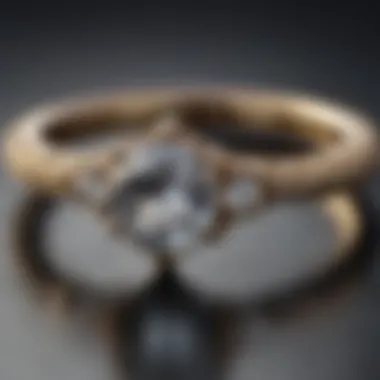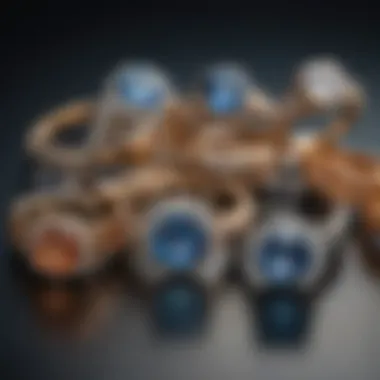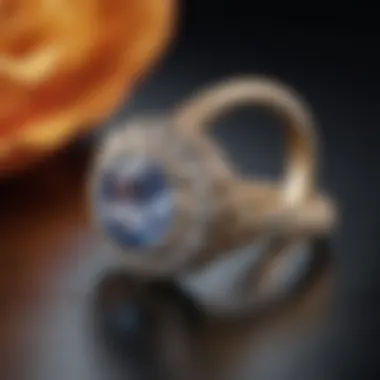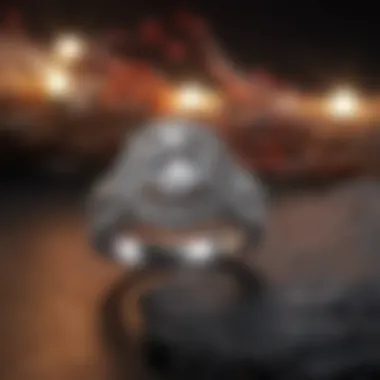Exploring Little Engagement Rings: Significance and Choices


Intro
Little engagement rings have become a significant trend in the jewelry industry. The growing interest in these understated symbols of commitment reflects a shift in consumer preferences. Understanding the nuances of these rings can provide valuable insights into their cultural significance, various styles, and materials. This article will offer a deep exploration of these elements, allowing enthusiasts and potential buyers alike to appreciate the charm of little engagement rings.
Gemstone Overview
Definition and Characteristics
Little engagement rings typically feature smaller gemstones, often of high quality. These rings can showcase various types of stones, from traditional diamonds to alternative options like sapphires or moissanite. The charm of a smaller stone lies in its elegance and the unique qualities each gemstone brings. The choice of gemstone significantly impacts the ring's overall aesthetic and emotional value.
Classification of Gemstones
Gemstones can be classified into various categories based on several factors. The primary classifications include:
- Precious Stones: Diamonds, rubies, sapphires, and emeralds are recognized for their rarity and durability.
- Semi-Precious Stones: These include amethyst, garnet, and aquamarine. While beautiful, they are often more abundant than precious stones.
- Alternative Stones: Social consciousness trends have led to the rise of moissanite and lab-created diamonds, which are both environmentally friendly and cost-effective.
Historical Significance
Ancient Uses and Cultural Importance
Throughout history, gemstones have served different purposes across cultures. In ancient societies, gemstones were often believed to possess mystical properties. They were used in rituals and as talismans for protection or luck. The symbolism behind specific stones often captured the essence of various cultures, embedding deeper meanings into engagement rings.
Myths and Legends Surrounding Gemstones
Countless myths surround the gemstones used in engagement rings. For example, the diamond is often associated with eternal love. Sapphires were thought to protect against envy and harm. These legends contribute to the allure and significance of gemstone selection in little engagement rings.
"The type of gemstone selected reflects the personality of the wearer and their unique story."
Understanding these aspects can help buyers make informed decisions when choosing a ring that resonates with personal values and tastes.
Intro to Little Engagement Rings
Little engagement rings are more than mere adornments; they represent a profound emotional connection and commitment between partners. This topic gains significance as it aligns with contemporary values that increasingly appreciate simplicity and personal meaning in expressions of love. The growing interest in little engagement rings provides an opportunity for couples to reflect on their priorities, emphasizing substance over ostentation.
Defining these rings involves understanding their unique characteristics. They are typically smaller in size yet often possess intricate designs, which can reflect the personalities of the individuals involved. As a result, they often encourage a deeper examination of the significance of the ring as a symbol of commitment, rather than focusing solely on its monetary value.
Defining Little Engagement Rings
Little engagement rings are distinguished by their understated charm. Unlike traditional engagement rings, which often feature large diamonds or gemstones, little engagement rings prioritize simplicity and elegance. They may include smaller-sized stones or unique materials that appeal to those who seek something distinctive.
These rings can represent various styles, from minimalist choices to vintage-inspired designs. For many, the allure of a smaller engagement ring lies in its subtlety and the personal touch it can convey. As couples embrace these rings, they often find themselves drawn to the narrative that accompanies each piece, whether it reflects personal values, heritage, or artistic expression.
Historical Context
The historical journey of engagement rings is quite fascinating. Traditionally, engagement rings served as tokens of commitment, and their meanings have evolved significantly over time. Earlier, such rings were made with simple materials like iron or gold, signifying the binding of two families rather than romantic love. It wasn’t until the late 19th century that diamonds became popularized in engagement jewelry, largely influenced by the marketing efforts of companies like De Beers.
The concept of a little engagement ring, however, has roots in more modern sentiments. As societal values shifted toward prioritizing personal expression, affordability, and ethical considerations, smaller rings gained traction. They symbolize a shift from extravagance to a more intimate representation of love, aligning with contemporary discussions surrounding sustainability and individuality in jewelry choices.
Cultural Significance
Cultural significance plays a crucial role in understanding little engagement rings and their value in today's society. These rings are not merely pieces of jewelry; they carry deep meanings and reflect personal stories. They symbolize commitment, love, and a promise for the future, but the scale of such symbolism can vary significantly, especially when considering the choice of a smaller ring.
Choosing a little engagement ring often indicates a thoughtful decision. Many couples see the smaller size as a representation of practicality or personal values. In some cultures, a smaller ring can convey modesty and a focus on the relationship rather than material wealth. This choice can also be a reaction against societal pressures that often associate love with extravagant displays of wealth.


Another aspect of cultural significance is the shift in fashion and societal values over the years. As awareness grows regarding sustainable practices and the ethical implications of jewelry production, more couples are leaning towards smaller, ethically sourced rings. This focus elevates the importance of the origin and the craftsmanship behind the ring, rather than its size. It emphasizes a significant trend towards minimalism and sustainability, reflecting broader societal changes.
In addition, little engagement rings can also emphasize personal stories or unique features that represent the couple's journey. A custom design that incorporates meaningful symbols or gemstones can hold more emotional value than a larger, conventional ring. Thus, it is essential to consider how these choices resonate within the broader cultural context that values individual expression.
Symbolism of Smaller Rings
The symbolism behind smaller engagement rings is multifaceted. Firstly, smaller rings reflect individuality and an appreciation for subtlety. This standpoint welcomes an expanding definition of beauty and significance. A small ring can hold just as much emotional weight as a larger one, often housing personal stories and shared memories.
From a symbolic standpoint, the size of the ring conveys a message. Couples choosing smaller rings often express that love does not depend on grandeur or extravagance. Instead, it underscores their connection and commitment as the most vital aspect of their relationship.
Moreover, smaller rings can also symbolize a return to authenticity. They invite contemplation about the significance of moments shared together, rather than flashy displays. Selecting such pieces can lead to conversations about values and priorities in relationships—redefining what commitment means beyond traditional expectations.
Global Perspectives on Engagement Rings
Globally, the perspectives on engagement rings exhibit vast cultural diversity. Different regions have unique traditions and expectations concerning size, material, and style. In some countries, like the United States, larger diamonds are often seen as the ideal when it comes to engagement rings. However, smaller engagement rings are gaining acceptance in various cultures, highlighting a shift in perceptions about what truly represents commitment.
In contrast, many cultures place greater weight on the act of giving itself, rather than the ring's size. For instance, countries like India traditionally focus on gold or other metals, where size is not the primary concern. Instead, the ring can serve as a mark of tradition and familial history.
Changing attitudes towards engagement rings correlate with broader societal views on marriage and commitment. Especially among younger generations, there is a noticeable trend toward prioritizing experiences over material possessions. The connection between love and consumerism is reevaluated, encouraging couples to express their commitment authentically through smaller, often more meaningful rings.
Design and Style Options
The design and style of little engagement rings hold significant value in the context of their rising popularity. This section analyzes those elements that define and differentiate such rings. Knowing the available styles helps shoppers make informed choices. Each design possesses its own personality and allure. Thus, merging style with personal preferences yields truly unique pieces.
Classic Designs
Classic engagement rings often symbolize timeless love. They usually feature simple yet elegant styles. Common options in this group are solitaire settings and three-stone arrangements.
- Solitaire Setting: A single stone enhances the beauty of a smaller ring. The focus is entirely on the gem, which may be diamond or another gemstone. The clean lines provide elegance without excess adornment. Visual appeal lies in simplicity.
- Three-Stone Setting: This design represents the past, present, and future of a relationship. With one central stone flanked by two smaller ones, it provides a more detailed aesthetic. This design conveys deeper meaning while still maintaining a smaller profile.
Classic designs have an enduring charm that resonates with many couples. They avoid trends that may feel temporary. Instead, classic styles offer stability, making them popular among various generations.
Contemporary Styles
Contemporary styles embrace a wider range of designs. They aim to capture modern sensibilities while frequently showcasing unique shapes and craftsmanship. These designs focus on form, often breaking traditional boundaries.
- Geometric Shapes: Many contemporary rings feature geometric designs. Shapes like square, oval, or unique cuts can standout prominently in a smaller ring setting. This choice provides an artistic touch while retaining simplicity.
- Mixed Materials: Combining metals or integrating colored gems into the design is common in contemporary settings. For example, a rose gold band paired with a sapphire stone forms an interesting contrast that appeals to modern tastes. This approach allows customization, appealing to individual preferences.
Contemporary options reflect innovation and creativity. They attract those seeking a unique statement piece, not just a traditional engagement ring.
Customization and Personalization
Customization and personalization provide an opportunity for individuals to express their unique tastes. Many jewelers today offer customizable options. This aspect is particularly appealing to couples who want their ring to represent their relationship's story.
- Engravings: Personalizing rings through engravings can add sentimental value. Couples often choose initials, dates, or meaningful quotes that represent their journey together. This small touch elevates the ring's significance.
- Stone Selection: Personalized choices are not limited to band designs. Selecting gemstones that signify personal meanings or birthstones can create deeper emotional connections. Each gem tells a different story.
Customizable design choices enhance the importance of the ring. The deeper meanings associated with personalized details foster a unique bond between the engaged couple.
"Engagement rings are not just jewelry; they hold the essence of a couple's commitment, values, and individuality."
This exploration of design and style options presents valuable insights for those interested in little engagement rings. Recognizing classic, contemporary, and customizable styles enables informed decisions tailored to personal tastes.
Materials Used in Little Engagement Rings


Understanding the materials used in little engagement rings is crucial for several reasons. First, the choice of materials directly impacts the visual appeal and durability of the ring. Second, different metals and gemstones can convey various meanings and symbolism. Lastly, as consumers increasingly seek ethical options, knowing the sourcing of these materials becomes even more important. An informed decision leads to a more meaningful purchase, aligning with personal values and aesthetic preferences.
Types of Metals
The metal selected for a little engagement ring plays a significant role in its overall appearance and longevity. Popular choices include:
- Yellow Gold: This traditional option exudes warmth and classic elegance. It can enhance the richness of colored gemstones.
- White Gold: A modern alternative, white gold offers a sleek and contemporary look. Often plated with rhodium, it adds shine and protection.
- Rose Gold: This unique, pink hue is gaining popularity. It brings a romantic and vintage touch, making it a favorite for those seeking something different.
- Platinum: Known for its strength and durability, platinum is hypoallergenic and resists tarnish. This makes it an excellent choice for daily wear.
Choosing the right metal involves considering both its durability and how well it compliments the chosen gemstone.
Gemstone Choices
Gemstones allow for expression and personalization, often reflecting the wearer's style. Traditional diamonds remain a popular choice, yet little engagement rings open the door to various alternatives:
- Sapphires: Available in multiple colors, sapphires symbolize loyalty and nobility.
- Emeralds: Associated with rebirth and love, emeralds provide a vivid green hue.
- Moissanite: A lab-created stone that resembles a diamond, it offers brilliance at a lower cost, appealing to budget-conscious consumers.
- Birthstones: Personal touch comes from choosing a gemstone that represents a particular month, making the ring uniquely personal.
Each gemstone comes with its own characteristics, which impacts both appearance and emotional significance.
Ethical Considerations
There is a growing awareness about the ethical implications of jewelry purchases. Consumers today increasingly want to know where their materials come from. For instance, conflict diamonds, often mined in dangerous conditions, present serious ethical concerns. Therefore, it is important to consider:
- Lab-Created Gemstones: These are produced in controlled environments, offering ethical alternatives to mined stones.
- Fair Trade Gold: This certification ensures that the gold is sourced responsibly, supporting community development and environmental sustainability.
- Sustainable Practices: Look for vendors who practice environmentally conscious methods in sourcing materials, ensuring minimal impact on the planet.
Market Trends and Consumer Preferences
Understanding the landscape of market trends and consumer preferences is crucial when exploring little engagement rings. These trends not only reflect the broader societal values but also indicate what consumers are looking for in their symbols of commitment. The increase in demand for little engagement rings signals a shift in priorities, emphasizing personal values and meaningful expressions over traditional norms. This section delves into two subcategories that examine the growing popularity and the changing attitudes towards size and cost in engagement rings.
Growing Popularity of Little Engagement Rings
The popularity of little engagement rings has seen a notable rise in recent years. Several factors contribute to this trend.
- Societal Shifts: Modern couples often prioritize experiences and travels over substantial expenditures on traditional engagement rings. As a result, smaller rings become a more attractive option.
- Minimalism: There is a noticeable movement towards minimalist aesthetics, where less is valued over ostentation. Little engagement rings align with this philosophy, offering elegance in simplicity.
- Sustainability: Bigger isn’t always better, especially with the increasing awareness about sustainable practices in jewelry sourcing. Smaller rings can often mean lower environmental impact, especially when using ethical materials.
Moreover, choosing a smaller ring allows for unique designs. Many gemologists and jewelry designers are keen to showcase intricate designs that might be overlooked in larger stones. They bring out the beauty and individuality of the smaller gems, ensuring they shine with character.
"The smaller engagement ring is not just a trend; it is a reflection of our values and priorities as a society."
Changing Attitudes Toward Size and Expense
Consumer preferences towards ring size and spending are evolving. Traditionally, a larger stone was synonymous with love and commitment. However, changing attitudes have altered this narrative dramatically.
- Cultural Influence: As younger generations become more involved in the purchasing process, they often view the size of the ring as less significant. There is a growing recognition that the value of a ring lies not in its size but in its sentiment.
- Financial Responsibility: Many couples are taking a more practical approach to their finances. The cost of larger rings can add unnecessary stress to a relationship. Opting for a little engagement ring can alleviate this pressure and allow for funds to be redirected to other meaningful areas, such as home ownership or travel.
- Communication of Personal Preferences: Couples now often discuss their preferences openly. This leads to mutual understanding and encourages choices that reflect the couple's unique bond, rather than societal expectations.
The shift towards little engagement rings is indicative of a more thoughtful consumer. This new mindset prioritizes personal connection, financial prudence, and sustainability. As society progresses, these considerations will likely continue to shape engagement ring trends for years to come.
Practical Considerations When Purchasing
Purchasing a little engagement ring requires careful thought and consideration. It is not just about choosing a piece of jewelry; it involves understanding one’s budget, sizing, and fit of the ring. This section will guide you through these practical aspects, emphasizing the importance of making well-informed decisions that fit your preferences and circumstances.
Assessing Your Budget
Establishing a budget is fundamental when buying an engagement ring. This applies especially to little engagement rings, which may be perceived as more accessible in terms of cost. However, it is crucial to consider not only the price of the ring itself but also potential additional expenses.


Factors to consider include:
- Metal Type: Different metals, such as platinum, gold, and silver, have varying prices. Each metal carries unique advantages and aesthetics.
- Gemstone Quality: The quality of the gemstone significantly affects the price. Factors like cut, clarity, color, and carat weight play an important role.
- Customization Fees: Many choose to customize their rings, which can add to the overall cost. Custom designs are often more expensive than pre-made options.
- Insurance and Appraisal: Protecting your investment is wise. Consider the costs of insuring the engagement ring.
By setting a realistic budget ahead, you can streamline your shopping process and avoid overspending. It also helps prioritize features you truly want in a ring.
Sizing and Fit
Finding the correct size for a little engagement ring is essential. A well-fitting ring is comfortable to wear and remains secure on the finger. Here are several aspects to consider when determining size:
- Measurement Methods: You can measure ring size at home using a string or a ring size chart. Popular local jewelers also provide professional sizing services.
- Finger Fluctuations: Be aware that fingers may change size due to temperature, humidity, or even health. It is best to measure at a consistent time.
- Style of the Ring: Consider the style of the ring. Wider bands may need a slightly larger size than narrower ones for a comfortable fit.
Fitting considerations can also include how the wearer’s lifestyle affects ring comfort. Someone with an active lifestyle may prefer a more snug fit to prevent loss.
Important Note: Rings that are too tight can cause discomfort, while loose rings risk falling off. Proper fitting improves wear and ensures the piece is treasured long-term.
Purchasing a little engagement ring involves several practical considerations. By assessing your budget and ensuring proper sizing, you are more likely to choose a ring that is not only beautiful but also suits your personal situation. Taking the time to plan and consider these elements can enhance the overall experience.
Care and Maintenance of Little Engagement Rings
Caring for little engagement rings is an often overlooked aspect of jewelry ownership. These delicate pieces deserve attention to maintain their beauty and integrity over time. Proper care ensures that the ring continues to symbolize the commitment it represents. Neglecting maintenance can lead to wear and tear, diminishing both value and appearance. By understanding the cleaning practices and storage solutions specific to little engagement rings, owners can keep them in excellent condition.
Cleaning Practices
Cleaning is crucial for preserving the sparkle of little engagement rings. Dust, grime, and oils from the skin can accumulate and dull the ring’s surface. Regular cleaning can help prevent build-up that could lead to damage over time. Here are some recommended practices:
- Gentle Soap and Water: A simple solution of warm water and mild dish soap can effectively remove dirt. Soaking the ring for a few minutes followed by gentle scrubbing with a soft brush, like a toothbrush, can work wonders.
- Avoid Harsh Chemicals: Stay away from abrasive cleaners or products containing bleach. These can damage metals and stones of the ring.
- Professional Cleaning: For more thorough cleaning, consider taking the ring to a jeweler. They can polish and clean the ring using professional methods that will ensure safety and cleanliness.
It's advisable to clean your little engagement ring every few weeks, depending on how often it is worn.
Regular maintenance prolongs the lifespan of your engagement ring and maintains its emotional significance.
Storage Solutions
How you store your little engagement ring can also contribute significantly to its care. Correct storage helps avoid scratches, tangles, and other potential hazards. Here are some practices for effective storage:
- Use a Soft Lining: Store the ring in a jewelry box with a soft lining. This will cushion the ring and minimize exposure to dust or scratches.
- Separate from Other Jewelry: Keeping engagement rings separate from other chains or rings avoids tangling or scratching. Consider using ring trays or individual compartments.
- Avoid Humidity and Heat: Store rings in a dry place. Excess humidity or exposure to heat can deteriorate the materials over time.
It is essential to have a routine for checking the ring’s condition in its storage to catch any potential issues early.
Epilogue: The Enduring Charm of Little Engagement Rings
Little engagement rings represent a unique aspect of commitment and personal expression. Their significance transcends mere aesthetics, delving into profound values cherished by many. When evaluating the charm of these understated rings, it's essential to recognize the underlying motivations guiding individual choices, the cumulative weight of cultural heritage, as well as modern preferences.
Reflecting Personal Values
Choosing a little engagement ring often stems from deeper reflections on personal values. For many, it is not just about the ring itself but what it signifies. Smaller stones can symbolize a shift toward minimalism and a celebration of individuality. This choice may resonate with ideals of sustainability or ethical concent, considering the environmental impact of jewelry production.
Moreover, selecting a modest-sized ring can indicate a couple’s stance on financial boundaries and the rejection of societal pressures pertaining to lavishness. Instead of succumbing to traditional expectations, couples are increasingly aligning their ring choices with their principles. The choice of a smaller ring thus becomes a personal statement, showcasing authenticity over mere opulence.
Future of Engagement Ring Trends
The future of engagement rings, particularly smaller ones, appears promising as attitudes continue to evolve. The trends indicate a society approaching transparency and authenticity in relationships.
- Sustainability: More consumers are becoming aware of ethical sourcing. Brands emphasizing conflict-free stones and recycled materials are gaining traction.
- Customization: Personalized designs are popular. Couples wish to create unique pieces that represent their shared stories.
- Cultural Influences: There is a rise in the willingness to incorporate diverse cultural elements into ring designs. This aspect supports the notion of multi-faceted identities, allowing people to celebrate their heritages.
"The power of little engagement rings lies in their ability to symbolize profound love, rather than mere extravagance."
For additional perspectives on jewelry trends, you may explore resources like Wikipedia on Engagement Rings, Britannica's Jewelry Overview, or visit Reddit’s Jewelry Community.







